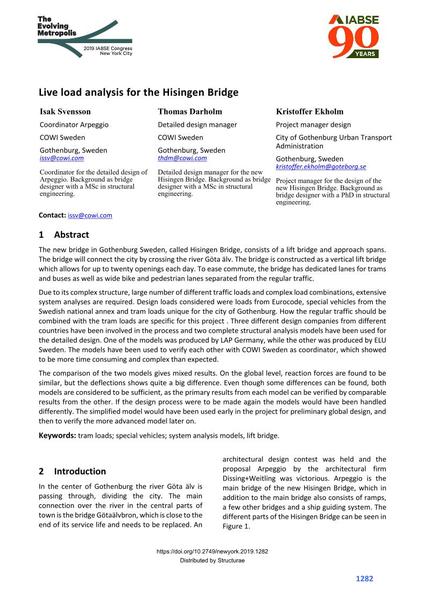Live load analysis for the Hisingen Bridge

|
|
|||||||||||
Bibliographic Details
| Author(s): |
Isak Svensson
(COWI Sweden)
Thomas Darholm (COWI Sweden) Kristoffer Ekholm (City of Gothenburg Urban Transport Administration) |
||||
|---|---|---|---|---|---|
| Medium: | conference paper | ||||
| Language(s): | English | ||||
| Conference: | IABSE Congress: The Evolving Metropolis, New York, NY, USA, 4-6 September 2019 | ||||
| Published in: | The Evolving Metropolis | ||||
|
|||||
| Page(s): | 1282-1287 | ||||
| Total no. of pages: | 6 | ||||
| DOI: | 10.2749/newyork.2019.1282 | ||||
| Abstract: |
The new bridge in Gothenburg Sweden, called Hisingen Bridge, consists of a lift bridge and approach spans. The bridge will connect the city by crossing the river Göta älv. The bridge is constructed as a vertical lift bridge which allows for up to twenty openings each day. To ease commute, the bridge has dedicated lanes for trams and buses as well as wide bike and pedestrian lanes separated from the regular traffic. Due to its complex structure, large number of different traffic loads and complex load combinations, extensive system analyses are required. Design loads considered were loads from Eurocode, special vehicles from the Swedish national annex and tram loads unique for the city of Gothenburg. How the regular traffic should be combined with the tram loads are specific for this project . Three different design companies from different countries have been involved in the process and two complete structural analysis models have been used for the detailed design. One of the models was produced by LAP Germany, while the other was produced by ELU Sweden. The models have been used to verify each other with COWI Sweden as coordinator, which showed to be more time consuming and complex than expected. The comparison of the two models gives mixed results. On the global level, reaction forces are found to be similar, but the deflections shows quite a big difference. Even though some differences can be found, both models are considered to be sufficient, as the primary results from each model can be verified by comparable results from the other. If the design process were to be made again the models would have been handled differently. The simplified model would have been used early in the project for preliminary global design, and then to verify the more advanced model later on. |
||||
| Keywords: |
Lift bridge tram loads special vehicles system analysis models
|
||||
